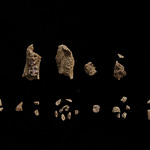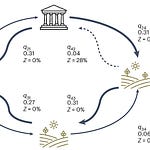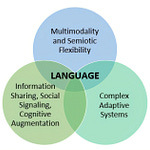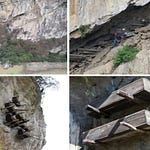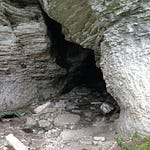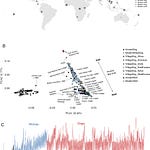In the sun-drenched soil of eastern Spain, where citrus groves meet ancient ruins, archaeologists have long chronicled the region's complex past. But bones often speak when texts fall silent. Now, DNA extracted from 12 individuals buried in cemeteries across Valencia has revealed1 a hidden history of cultural suppression and demographic transformation. The study, led by Gonzalo Oteo-García and colleagues, shows how centuries of coexistence between Europe and North Africa were violently severed in the 17th century—and how their echoes lingered in the genomes of the dead until that point.

Layers of Ancestry Beneath Christian and Islamic Stones
Through high-resolution sequencing of ancient genomes dating from the 3rd to the 17th century CE, researchers traced the region's complex population history across Roman, Islamic, and Christian eras. What emerged was the genomic footprint of a multicultural past, slowly effaced by war, conversion, and expulsion.
Among the most telling finds were two individuals buried in the same pit in Gandía—a man and his daughter. Their burial dates to around the time of the Islamic conquest of Iberia (711 CE), but their DNA tells a story of mixed ancestry. The father's genome carries significant North African ancestry, while the daughter's does not, indicating intermarriage between North African and Iberian populations within a single generation.
“This admixture wasn't just political or cultural,” the researchers note. “It was deeply personal and familial.”
Across five Islamic-period burials from Vall d’Uixó, the team found a consistent pattern of mixed North African and Iberian ancestry. These individuals likely belonged to the Muladís—local converts to Islam who embodied centuries of integration. Their genomes showed signs of both western Mediterranean and Levantine roots, with some carrying haplogroups common in North Africa today.
The Sudden Vanishing of Genetic Diversity
The turning point came in the early 1600s. Following rising tensions, forced conversions, and increasing restrictions, King Philip III of Spain ordered the expulsion of the Moriscos—Muslims who had converted to Christianity under duress. Historical records describe the departure of hundreds of thousands. What the genomes reveal is the scale of that disappearance.
Two Christian-period individuals buried in Valencia before the expulsion still bore substantial North African ancestry. But by the 17th century, that signal vanishes. One man, GOG60, shows no trace of it. His genome aligns squarely with modern Spanish populations.
“The genetic bridge between Europe and North Africa, visible for centuries, collapses abruptly after 1609 CE,” the study finds.
A contrasting case is GOG59, a man of clear North African descent buried with iron shackles around his leg. His remains suggest he was enslaved during one of the many Christian raids on the Barbary Coast. His DNA clusters closely with present-day Moroccan Berbers.
A Genetic Displacement with Transatlantic Echoes
One paradox the study addresses is the presence of North African ancestry in modern South American populations. Spanish colonial authorities barred Moriscos from emigrating, fearing divided loyalties. But the high levels of Maghrebi ancestry in Latin America suggest many Moriscos left Europe before the expulsion, carrying their genomes—and cultural legacies—across the Atlantic.
“The Iberian emigrants who settled the Americas carried more North African ancestry than is found in Spain today,” the authors argue.
Echoes in Bone and Blood
This study, published in Genome Biology, not only reconstructs a hidden demographic history but also foregrounds how ethnic cleansing shapes the genomic record. Despite centuries of convivencia in medieval Spain, the forced removal of Moriscos disrupted a stable, hybrid population, leaving little genetic trace in today's Valencian gene pool.
In the ruins of rural maqbaras and under the stones of urban churches, the DNA of the departed preserves a record of diversity lost. The cemeteries may have been forgotten. But in the silence of their bones, the memory of expulsion persists.
Further Reading and Related Research
Silva, M., et al. (2021). Biomolecular insights into North African-related ancestry, mobility and diet in eleventh-century Al-Andalus. Scientific Reports, 11(1), 18121. https://doi.org/10.1038/s41598-021-97339-5
Olalde, I., et al. (2019). The genomic history of the Iberian Peninsula over the past 8000 years. Science, 363(6432), 1230–1234. https://doi.org/10.1126/science.aav4040
Rodríguez-Varela, R., et al. (2024). Five centuries of consanguinity, isolation, health, and conflict in Las Gobas: a northern medieval Iberian necropolis. Science Advances, 10(35), eadp8625. https://doi.org/10.1126/sciadv.adp8625
Silva, M., et al. (2021). North African-related ancestry in medieval and early modern Spain: Insights from ancient DNA. Nature Communications, 12(1), 4166. https://doi.org/10.1038/s41467-021-24339-z
Botigué, L. R., et al. (2013). Gene flow from North Africa contributes to differential human genetic diversity in southern Europe. Proceedings of the National Academy of Sciences, 110(29), 11791–11796. https://doi.org/10.1073/pnas.1306223110
Oteo-Garcia, G., Silva, M., Foody, M. G. B., Yau, B., Fichera, A., Alapont, L., Justeau, P., Rodrigues, S., Monteiro, R., Gandini, F., Rovira Gomar, M. L., Ribera I Lacomba, A., Pascual Beneyto, J., Mattiangeli, V., Bradley, D. G., Edwards, C. J., Pala, M., & Richards, M. B. (2025). Medieval genomes from eastern Iberia illuminate the role of Morisco mass deportations in dismantling a long-standing genetic bridge with North Africa. Genome Biology, 26(1), 108. https://doi.org/10.1186/s13059-025-03570-1


